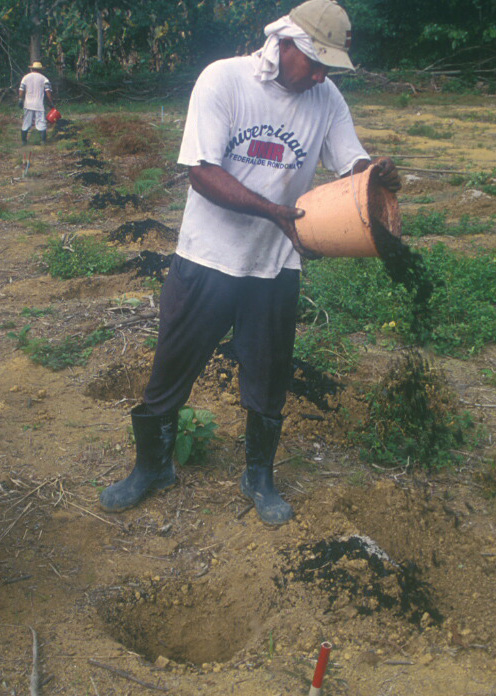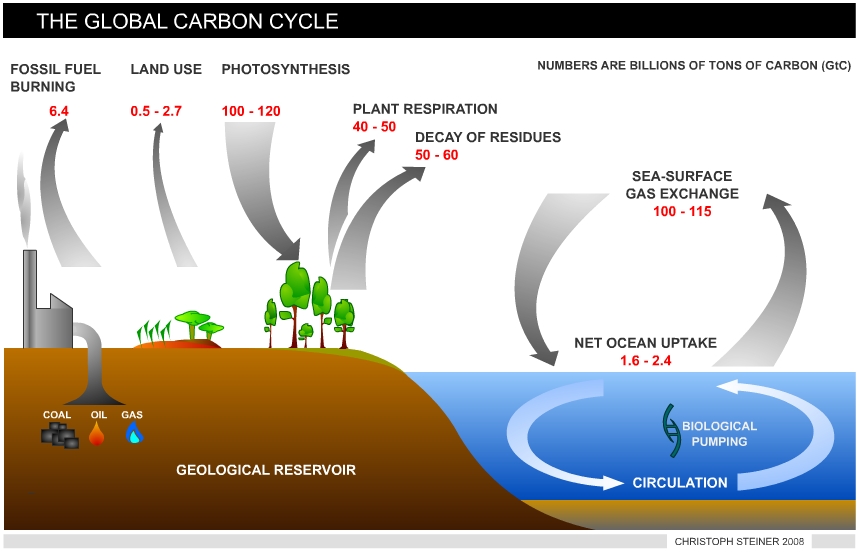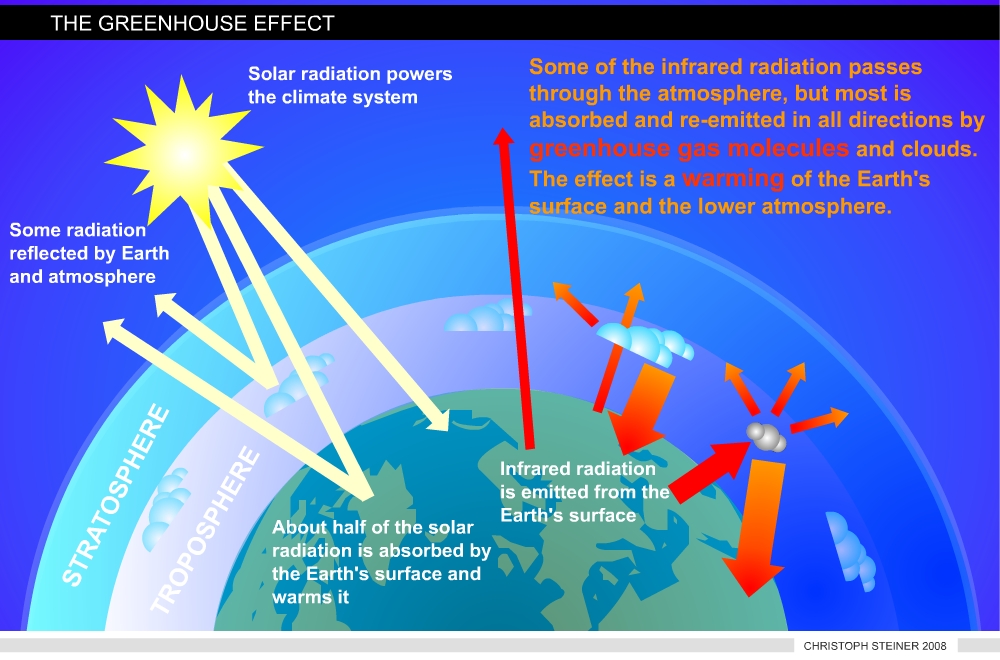The Miracle of Biochar
How to Regenerate Soils and Heal the Atmosphere
 Most carbon in the soil is lost as greenhouse gas (carbon dioxide, CO2) into the
atmosphere if natural ecosystems are converted to agricultural land. Soils
contain 3.3 times more carbon than the atmosphere and 4.5 times more than
plants and animals on earth (1). This makes soils an important source of
greenhouse gases but also a potential sink if right management is applied.
The use of crop residues for bio-energy production reduces the carbon stocks
in cropland. Further the dedication of cropland to bio-fuel production
increases the area of cultivated land and thus carbon loss from soils and
vegetation.
Most carbon in the soil is lost as greenhouse gas (carbon dioxide, CO2) into the
atmosphere if natural ecosystems are converted to agricultural land. Soils
contain 3.3 times more carbon than the atmosphere and 4.5 times more than
plants and animals on earth (1). This makes soils an important source of
greenhouse gases but also a potential sink if right management is applied.
The use of crop residues for bio-energy production reduces the carbon stocks
in cropland. Further the dedication of cropland to bio-fuel production
increases the area of cultivated land and thus carbon loss from soils and
vegetation.Pyrolysis of waste biomass can generate fuels and biochar recalcitrant against decomposition. If biochar is returned to agricultural land it can increase the soil’s carbon content permanently and would establish a carbon sink for atmospheric CO2. In this case the use of crop residues as a potential energy source may improve soil quality and reduce greenhouse gas emissions in a complementary not competing way.
Biochar
is proposed as a soil amendment in environments with low carbon sequestration
capacity and previously depleted soils (especially in the Tropics). From
previous studies it is known that soil biochar amendments increase and
maintain soil fertility (2) and the human-made
Terra Preta soils in the Ama-zon prove that infertile soils can be
transformed into fertile soils and long term carbon enrichment is feasible
even in environments with low carbon sequestration capacity (3).
The
Greenhouse Effect and Climate Change
Climate change and global warming are two terms used for the predicted and observed increase in temperature. While the current temperature increase is caused by human influence on the earth’s carbon cycle, the greenhouse effect is a naturally occurring process. In fact, without this process life on planet Earth would be rather unlikely. Short-waved radiation from the sun is able to permeate the atmosphere (about 55%). The reflected radiation from Earth’s surface has a longer wave length (infrared). The majority of this outgoing radiation is absorbed by the so called greenhouse gases (such as carbon dioxide, water vapor, methane, and nitrous oxide) in the atmosphere (Figure 1).
This process changes the energy balance of the planet
just as the glass roof of a greenhouse. This natural process rises the
Earth’s temperature by 33° Celsius to an average of 15° Celsius. The amount
of heat energy retained by the atmosphere is controlled by the concentration
of greenhouse gases and they are balanced by the action of life. Without life
the composition of the Earth’s atmosphere would be different.
|
The global
carbon cycle exchanges carbon (as CO2) between carbon reservoirs. These include
(4): • The atmosphere (720 Gt = billion tons) • The terrestrial biosphere
(2,000 Gt) • the oceans (38,400 Gt) • marine sediments and rocks (Lithosphere
> 60,000,000 Gt) and fossil fuels (4,130 Gt) = coal (3,510 Gt),
oil (230 Gt), gas (140 Gt) and others (250 Gt)
Terrestrial ecosystems and the oceans exchange CO2 rapidly with the atmosphere. The carbon exchange from the lithosphere is very slow, although some CO2 is released by volcanoes. CO2 is removed from the atmosphere through photosynthesis and stored in organic matter. When plants grow they utilize sunlight, CO2 and water (H2O) to synthesize organic matter (photosynthesis) and release oxygen (O2, see equation 1).
Equation 1 Light
↓
CO2 + 6H2O → C6H12O6 + 6O2
This organic matter is returned to the atmosphere by decomposition of dead plant tissue or distur-bances, such as fire, in which large amounts of organic matter are oxidized and rapidly transferred into CO2. Terrestrial carbon is primarily stored in forests (5). In undisturbed full-grown forest ecosystems, the turnover time of carbon is on the order of decades and uptake by photosynthesis and release by decay is balanced.

Figure 2 Sources and sinks of CO2 - The
global carbon cycle
Atmospheric CO2 increased to 379ppm in 2005 (Figure 3).
Ice core records reveal that we have left the domain that defined the Earth
system for the 420,000 years before the Industrial Revolution (4) in a speed
never occurred before (Figure 3).
CO2 is the most important anthropogenic GHG and its annual emissions grew by about 80% between 1970 and 2004. The current level exceeds by far the natural range over the last 650,000 years. The in-creases in GHG concentrations are mainly caused by fossil fuel burning and land-use change provides another significant contribution (Figure 5)
Greenhouse Gas (GHG) Emissions from Agriculture
Measurable anomalous emissions of GHG began already 8000 years ago. These early anthropogenic CO2 emissions were caused by forest clearing in Eurasia for agricultural purposes, and methane (CH4) emission rose from widespread rice irrigation about 5000 years ago (6). After 1750 the increase in atmospheric CO2 was mainly caused by fossil fuel combustion but emissions from land use change contributed about 30%, from which more than half is estimated from depletion of carbon in the soil. This depletion is exacerbated by further soil degradation and desertification (7).
The total soil carbon (organic and inorganic) is 3.3
times the size of the atmospheric carbon pool (1). As most agricultural soils
have lost 50 to 70% of their original carbon (7) they represent a
considerable carbon sink if efforts are made to restore soil organic carbon,
but also a huge source of GHG if soil management and deforestation rates are
not changed. There is high agreement and much evidence that with current
climate change mitigation policies and related sustainable development
practices, global GHG emissions will continue to grow over the next few
decades (25-90% between 2000 and 2030) (8).
|
Figure 3 increases in the
most important greenhouse gases (www.ipcc.ch)
Figure
4 use of fossil energy (nat-ural gas) for nitrogen (fertilizer) synthesis
|
Soil
organic carbon is not only an important source or sink of CO2 but also
important for soil fertility. Before the invention of mineral fertilizers,
management of organic carbon was the only way to restore or maintain soil
fertility. Sedentary farmers either depleted their carbon stocks for nutrients,
facing nutrient depletion, or found ways to maintain soil organic carbon.
Migration is the solution to nutrient depletion for an estimated 300 to 500
million people affecting al-most one third of the planet’s 1500 million ha of
arable land (9, 10).
This
agricultural system is termed “shifting cultivation”, indicating moving from
one spot to another as soil fertility declines. Decreasing soil carbon contents
correlate with a decline in agricultural productivity. The relationship between
soil fertility and soil organic carbon was well known in the first half of the
19th century as the German agronomist Albrecht Thaer published his “Humus
Theory”. Thaer’s approach, and quantitative assessment of agro-ecological and
economic sustainability of farming systems was used with success during half a
century, until 1849 when Sprengel and Liebig published on mineral nutrition of
plants (13). From then on the “minimal nutrition theory” progressively
abandoned recycling of nutrients from settlements to agricultural fields (14).
Mineral fertilization boosted crop production and replenished nutrient stocks
but did not treat soil degradation accompanied by accelerated loss of carbon.
The observed loss of soil organic carbon is associated with yield decreases,
reduced nutrient cycling and reduced nutrient-use efficiency of applied
fertilizer (3, 9, 11, 12).
Figure 6 Manmade Terra Preta soil in the
Brazilian Amazon. These soils were enriched with charcoal and nutrients and
prove that long lasting carbon enrichment and sustained soil fertility is
possible even in the tropics.
|
Figure 7 shows the values of soil organic
matter (SOM) and its implications on the environment, agronomy, and quality
of life. Redrawn and lightly modified from (Lal 2004)
|
Throughout the world intensive agricultural land use often has resulted in soil physical and chemical degradation, erosion, and higher losses than input rates of nutrients and organic materials. In contrast, the intentional and unintentional deposition of nutrient-rich materials within human habitation sites and field areas has in many cases produced conditions of heightened fertility status. An anthropogeni-cally-enriched dark soil found throughout the lowland portion of the Amazon Basin and termed
Terra
Preta de Índio is one such example (16). These soils contain high
concentrations of charcoal (17); signifi cantly more plant available nutrients
than in the surrounding soils (18). The existence of Terra Preta proves that
infertile soils can be transformed into permanently fertile soils in spite of
rates of weather-ing 100 times greater than those found in the mid-latitudes.
Such a transformation cannot be achieved solely by replenishing the mineral
nutrient supply (3).
It is important to separate effects due to organic matter per se (maintenance and improvement of water infiltration, water holding capacity, structure stability, retention of nutrients, healthy soil biologi-cal activity) from those due to decomposition (19, source of nutrients).
It is important to separate effects due to organic matter per se (maintenance and improvement of water infiltration, water holding capacity, structure stability, retention of nutrients, healthy soil biologi-cal activity) from those due to decomposition (19, source of nutrients).
Carbon
is an important indicator of soil quality, and has numerous direct and indirect
impacts on it such as, improved structure and tilth, reduced erosion, increased
plant-available water capacity, water purification, increased soil
biodiversity, improved yields, and climate moderation. This is essential to
sustain the quality and productivity of soils around the globe, particularly in
the tropics where there is a greater proportion of nutrient poor soils with a
greater susceptibility to carbon loss (Due to faster decomposition in a hot and
humid climate).
Increasing
carbon stocks in soils with conventional means e.g. conservation tillage, use
of manures, and compost, conversion of monoculture to complex diverse cropping
systems, meadow-based rotations and winter cover crops, and establishing
perennial vegetation on contours and steep slopes can sequester carbon. The
sequestration potential depends on climate, soil type, and site specific management.
The drawback of carbon enrichment with conventional methods is that carbon
level drops rapidly again, as soon as the required careful management is no
longer sustained. Carbon contents of cropland increases only if either carbon
additions (in form of plant biomass) are enhanced or decomposition rates
reduced (20). Only one-third of the aboveground residues remain in the soil
after 1year and only 10-20% remains after 2 years. Furthermore the addition of
degradable crop residues and reduced tillage systems can increase nitrous oxide
and methane (N2O and CH4, both potent GHGs) emissions substantially.
Figure 8 shows a simplified version of the
carbon cycle in vegetation and soil. Plants take CO2 from the atmosphere to
synthesize tissue (plant biomass). As long as biomass is growing it accumulates carbon. During
decomposition of dead biomass and humus the carbon is released as CO2. In
undisturbed ecosystems the accumulation and release of CO2 is in equilibrium.
|
 |
Figure 9 illustrates the manipulated
carbon cycle due to bio-char carbon sequestration. Biochar is recalcitrant
against decomposition and remains in the soil for centuries or mil-lennia.
Thus pyrolysis can transfer 50% of the carbon stored in plant tissue from the
active to an inactive carbon pool. The remaining 50% of carbon can be used to
produces energy and fuels. This enables carbon negative energy generation if
re-growing resources are used. (I.e. with each unit if energy produced CO2 is
removed from the atmosphere).
|
Reduced decomposition is an advantage of biochar (Figure
10). Biochar formation has important impli-cations for the global carbon
cycle. In natural and agroecosystems residual charcoal is produced by
in-complete burning. As the the soil carbon pool declines due to cultivation,
the more resistant charcoal fraction increases as a portion of the total
carbon pool (21-23) and may constitute up to 35% of the total (23). Carbon
dating of charcoal has shown some to be over 1500 years old, fairly stable,
and a permanent form of carbon sequestration (7). Inspired by recreation of
Terra Preta, slash and char was described as an alternative to slash and burn
(24). If a forest is burned, only around 2-3% of the above-ground carbon is
converted into charcoal (25), but charcoal production can capture 50% of the
above-ground carbon.
If re-growing resources (fallow vegetation or crop
residues) are used, slash and char could become a significant carbon sink and
an important step towards sustainability of tropical land use systems. The
global potential of biochar reaches far beyond slash and char. Systems
(pyrolysis) converting bio-mass into energy (hydrogen-rich gas and bio-oil)
and producing biochar as a by-product offer an opportunity to combine
renewable energy production, carbon sequestration and soil restoration.
Figure 10 demonstrates the
historical knowledge about the recalcitrance of charcoal. Wooden poles were
(are) blackened (carbonized) on the outside to increase their persistence in
soil (photo C. Steiner).
Biochar can be produced by incomplete combustion from
any biomass, and it is a by-product of the pyrolysis technology used for
biofuel and bioenergy production. The carbon cycling from photosynthesis and
decomposing organic materials is 50 to 60 billion tons (Gt) per year and land
use emits approximately 0.5 to 2.7 Gt of carbon (Figure 2). It would make a
significant global impact, if only a small fraction of this carbon flux is
altered by biochar carbon sequestration.
Carbonization of agricultural and forestry wastes could
capture 0.16 Gt carbon yr-1. If the demand for renewable fuels by the year
2100 was met through pyrolysis, biochar sequestration could exceed current
emissions from fossil fuels (26).
|
|
NEXT>
Continues with footnotes @ http://www.biochar.org/joomla/index.php?option=com_content&task=view&id=67&Itemid=7&limit=1&limitstart=5
For
more information about soil remineralisation see http://nexusilluminati.blogspot.com/search/label/soil%20remineralisation
-
See ‘Older Posts’ at the end of each section
YOU can help this unique
independent website’s author survive in a small cabin in a remote rainforest
Donate any
amount and receive at least one New
Illuminati eBook!
Please drop it in the jar -
For
further enlightening information enter a word or phrase into the random
synchronistic search box @ http://nexusilluminati.blogspot.com
And see
New Illuminati – http://nexusilluminati.blogspot.com
New Illuminati on Facebook - https://www.facebook.com/the.new.illuminati
New
Illuminati Youtube Channel - http://www.youtube.com/user/newilluminati/feed
The
Her(m)etic Hermit - http://hermetic.blog.com
The Prince of Centraxis - http://centraxis.blogspot.com (Be Aware! This link leads to implicate &
xplicit concepts & images!)
DISGRUNTLED SITE ADMINS PLEASE
NOTE –
We provide a live link to your
original material on your site - which raises your ranking on search engines
and helps spread your info further! This site is published under
Creative Commons Fair Use Copyright (unless an individual article or other item
is declared otherwise by copyright holder) – reproduction for non-profit
use is permitted & encouraged, if you give attribution to the work &
author - and please include a (preferably active) link to the original (along
with this or a similar notice).
Feel free to make non-commercial hard (printed) or
software copies or mirror sites - you never know how long something will stay
glued to the web – but remember attribution! If you like what you see, please
send a donation (no amount is too small or too large) or leave a comment – and
thanks for reading this far…
Live long and prosper!
From the New Illuminati – http://nexusilluminati.blogspot.com

No comments:
Post a Comment
Add your perspective to the conscious collective